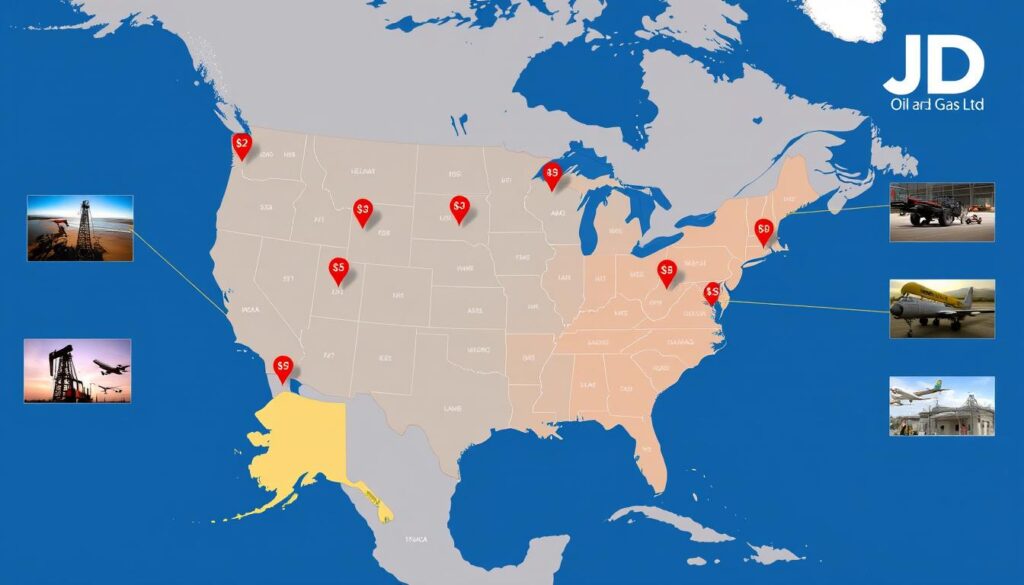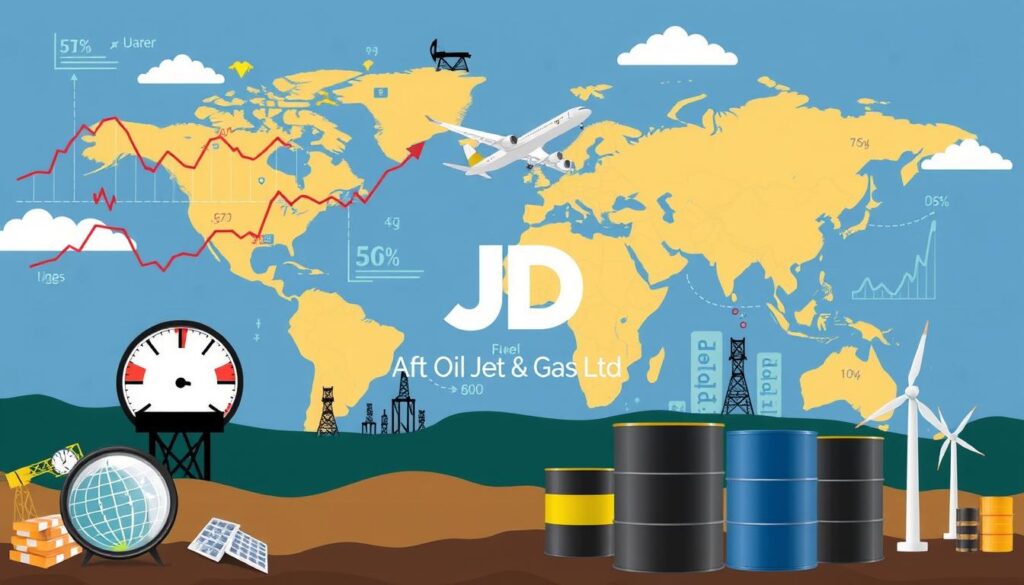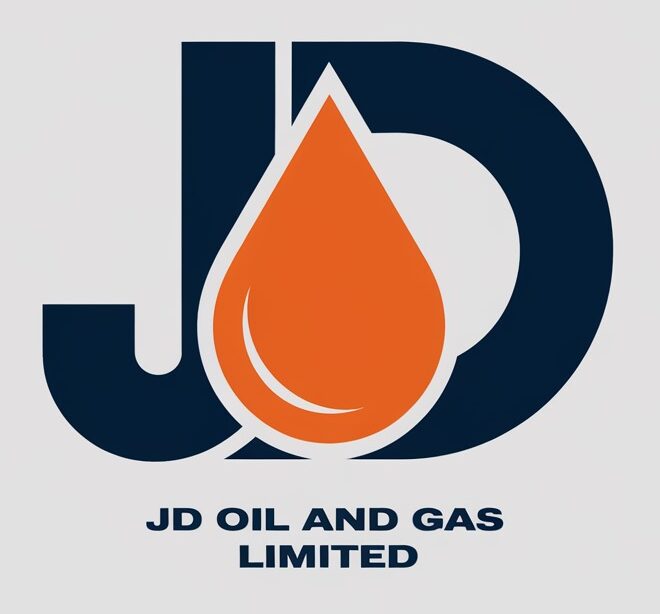The cost of jet fuel is a big deal in the aviation world. It affects both airlines and travelers. Understanding jet fuel prices is key to seeing how the industry is changing.
Last week, the global jet fuel price averaged $89.21 per barrel. This is a 2.9% drop from the week before. In Canada, jet fuel costs $6.21 per gallon on average. Sustainable Aviation Fuel (SAF) is priced at $8.88 per gallon, showing a push towards greener options.
Prices vary by region. The FAA Alaska region has the highest jet fuel price at $8.19 per gallon. The FAA Central region has the lowest at $5.55 per gallon. These differences show the complex nature of the aviation fuel market.
Key Takeaways
- The global average jet fuel price last week was $89.21 per barrel, a 2.9% decrease from the previous week.
- The national average price for jet fuel in Canada is $6.21 per gallon, while Sustainable Aviation Fuel (SAF) has a national average price of $8.88 per gallon.
- Regional variations in jet fuel prices are significant, with the FAA Alaska region reporting the highest average of $8.19 per gallon and the FAA Central region the lowest at $5.55 per gallon.
- Factors such as global supply and demand, geopolitical tensions, and refinery capacity are key drivers of jet fuel price fluctuations.
- The aviation industry’s transition towards more sustainable fuel options, such as SAF, aims to reduce the environmental impact of air travel.
Understanding Global Aviation Fuel Markets
The global aviation fuel market is complex and always changing. It includes different types of jet fuel, big players, and wide distribution networks. Understanding jet fuel is key to grasping trends and prices in the aviation world.
Defining Jet Fuel Types
Jet fuel types include Jet A, Jet A-1, and Sustainable Aviation Fuel (SAF). Each fuel has its own special features and uses. They meet the needs of both commercial and military planes globally.
Major Market Players
Big names like ExxonMobil, Chevron, Shell, and TotalEnergies lead the market. They are key in making, spreading, and setting prices for jet fuel. Their actions greatly influence the market.
Global Distribution Networks
Getting jet fuel to airports on time is a big task. It’s solved by a vast network of pipelines, storage, and transport. This network keeps the aviation world running smoothly.
S&P Global Platts is a major player in jet fuel price tracking. Their Platts Jet Fuel Price Index is a key indicator. It shows market trends and price changes that affect the aviation fuel market.
| Key Aviation Fuel Market Statistics | Value |
|---|---|
| Global Aviation Fuel Market Size (2024 Estimate) | USD 328 billion |
| Global Aviation Fuel Market Projected Size (2034) | USD 1,215.97 billion |
| Global Aviation Fuel Market CAGR (2024-2034) | 14% |
| Global Sustainable Aviation Fuel Market Value (2022) | USD 433.26 million |
| Global Sustainable Aviation Fuel Market Projected Value (2032) | USD 14,842.13 million |
| Global Sustainable Aviation Fuel Market CAGR (2022-2032) | 42.39% |
The jet fuel market analysis shows a fast-changing scene. It’s driven by more air travel, green fuel tech, and big players’ strategies. As global jet fuel prices change, comparing conventional and green fuels is vital for the industry’s future.
Current Jet Fuel Price Analysis 2024
The aviation industry is slowly getting back on track, and jet fuel prices are key. As of November 24, 2024, the U.S. national average for jet fuel is $6.21 per gallon.
The Platts Jet Fuel Price Index is a top industry benchmark. It tracks jet fuel spot prices in major areas daily. Over the last 24 months, prices have seen ups and downs. Recently, global prices have slightly dropped compared to earlier this year.
This index compares today’s prices to the 2000 average, weighted by demand back then. It helps those in aviation understand jet fuel cost trends and price of aviation fuel in historical context.
| Region | Jet Fuel Price (per gallon) |
|---|---|
| New York | $6.35 |
| Gulf Coast | $6.05 |
| Group 3 | $6.16 |
| Chicago | $6.27 |
| Los Angeles | $6.41 |
Prices vary by region, with the Gulf Coast at $6.05 and Los Angeles at $6.41. These differences show how important it is to know local markets. They affect the costs airlines and operators face.
“The aviation industry’s resilience and adaptability will be crucial in navigating the fluctuating jet fuel prices in the coming year.”
How Much Is Jet Fuel: Breaking Down the Costs
The aviation industry faces changing jet fuel cost per gallon prices. It’s important to know what affects the price of aviation fuel. We’ll look at national averages and regional differences in aviation industry fuel costs.
National Average Prices
In the United States, jet fuel costs $6.21 per gallon on average. For 100LL aircraft fuel, used in smaller planes, the average is $6.52 per gallon. These numbers help us understand the jet fuel cost per gallon nationwide.
Regional Price Variations
Prices for aviation fuel vary by region. The FAA Alaska region has the highest price at $8.19 per gallon. The FAA Central region has the lowest at $5.55 per gallon. These differences are due to supply, distribution, and local market factors.
Price Components and Taxes
The aviation industry fuel costs include more than just fuel price. U.S. government taxes and distribution costs also affect the price. These extra costs can significantly impact the jet fuel cost per gallon for airlines and others in the industry.
“The national average price for jet fuel is $6.21 per gallon, while 100LL aircraft fuel averages $6.52 per gallon.”

Regional Price Differences Across North America
In North America, the price of aviation fuel varies a lot by region. This is important for airlines and private flying companies. They need to keep their fuel costs down to stay profitable.
The FAA Alaska region has the highest jet fuel price at $8.19 per gallon. The highest 100LL price is $10.44 per gallon. On the other hand, the FAA Central region has the lowest prices. Jet fuel costs $5.55 per gallon, and 100LL is $6.01 per gallon. These differences come from things like how fuel is transported, local taxes, and how fuel is supplied in each area.
| Region | Jet Fuel Price (per gallon) | 100LL Price (per gallon) |
|---|---|---|
| FAA Alaska | $8.19 | $10.44 |
| FAA Central | $5.55 | $6.01 |
It’s key for airlines and private flying to understand these aviation fuel price differences. By keeping an eye on jet fuel market analysis and regional jet fuel prices, they can make better choices. This helps them improve their profits and stay competitive.

“Understanding the nuances of regional fuel pricing is essential for any aviation business seeking to maximize its efficiency and cost savings.”
Sustainable Aviation Fuel (SAF) Market Overview
Sustainable Aviation Fuel (SAF) is changing the game for air travel. Over 360,000 flights have used SAF at 46 airports, mainly in the U.S. and Europe. This shows growing demand for a cleaner fuel.
Current SAF Pricing
The average price for SAF is $8.88 per gallon, more than jet fuel’s $2.29. Despite this, airlines and companies are willing to pay extra for SAF. They pay about $6 per gallon and $300 per ton of CO2 saved.
Sustainability Benefits
SAF offers more than just a higher price. Aviation is responsible for 2% of global CO2 emissions and 12% of transportation emissions. Using SAF can greatly reduce these emissions, helping reach net-zero by 2050.
Future Market Projections
The global SAF market is expected to grow from $1.1 billion in 2023 to $16.8 billion by 2030. This growth is due to the need to cut greenhouse gas emissions and increasing demand from airlines and companies. Yet, challenges like feedstock shortages and high operating costs must be overcome.
“The Sustainable Aviation Fuel Grand Challenge aims to expand domestic SAF consumption to 3 billion gallons in 2030 and 35 billion gallons in 2050.”
As air travel focuses on sustainability, SAF will be key in making air travel greener.
Factors Affecting Aviation Fuel Prices
The cost of fuel for the aviation industry is influenced by many factors. These include the global crude oil market, geopolitical events, supply and demand, and currency changes. Changes in the Platts Jet Fuel Price Index can cause big price swings. This makes it hard for airlines and the aviation sector.
One big factor is the cost of crude oil. Since Russia invaded Ukraine, Brent crude oil prices have gone up over 26% to $140 a barrel. This rise is due to a shortage of oil meeting demand, especially after the U.S. and U.K. banned Russian imports.
Geopolitical tensions and supply chain issues also affect fuel costs. For example, in the last 12 months, fuel prices in Europe have gone up by over 115%. In just 3 weeks, the fuel price index jumped from 303.8 to 383.4 (dated 18 March), showing how volatile the market is.
Other factors like global economic conditions, technological advancements in fuel efficiency, and environmental regulations also play a role. The aviation industry is looking at sustainable aviation fuel (SAF) to cut its carbon footprint and deal with price volatility.
“The European Business Aviation Association (EBAA) is advocating for pricing regulations to help the business aviation industry cope with rising jet fuel prices.”
Understanding what drives jet fuel prices is key for airlines, aviation companies, and policymakers. It helps them make smart decisions and strategies to manage fuel costs. This is crucial for the industry’s long-term success.

| Factor | Impact on Jet Fuel Prices |
|---|---|
| Crude Oil Prices | Directly correlated; increases in crude oil prices lead to higher jet fuel costs |
| Geopolitical Events | Disrupt supply and demand, causing price volatility and spikes |
| Supply and Demand Dynamics | Changes in global air travel demand and refining capacity affect prices |
| Currency Fluctuations | Variations in exchange rates impact the cost of jet fuel for airlines |
| Global Economic Conditions | Affect air travel demand and influence long-term price trends |
| Technological Advancements | Improvements in fuel efficiency can help mitigate rising fuel costs |
| Environmental Regulations | Policies and initiatives to reduce emissions may impact jet fuel pricing |
Price Trends and Historical Data Analysis
Understanding the trends and historical data is key to grasping the aviation fuel market. Jet fuel spot prices have seen big changes over 60 days and the past year. This shows how volatile this industry can be.
60-Day Price Movements
The Platts Jet Fuel Price Index gives us detailed historical data. It helps us see how prices have moved and compare them to the past. This data shows the quick price changes that airlines face often.
Annual Price Patterns
Jet fuel prices often follow seasonal patterns, matching changes in air travel demand. By looking at yearly trends, we can understand what drives these changes. This helps us see how these changes affect the aviation industry’s costs and profits.
Market Volatility Factors
Many things affect jet fuel price volatility, like geopolitical events, natural disasters, and global economic conditions. Knowing these factors is key for airlines and industry players. It helps them manage their fuel costs and risks better.
| Year | Jet Fuel Price ($/gallon) | Percentage Change |
|---|---|---|
| 2022 | 3.45 | +24.5% |
| 2021 | 2.77 | +50.8% |
| 2020 | 1.84 | -38.7% |
| 2019 | 2.99 | -3.9% |
| 2018 | 3.11 | +32.9% |
The table shows jet fuel prices and their changes from year to year. It gives us a clear view of the market’s ups and downs. It also shows how the industry reacts to these changes.
Commercial Airline Fuel Expenses
Fuel costs are a big part of what airlines spend on running their operations. The A4A Passenger Airline Cost Index (PACI) shows how much fuel costs affect airlines’ profits. In 2019, United Airlines spent $8.9 billion on fuel, which was about 23% of its total expenses.
Fuel prices can change a lot, making it hard for airlines to plan their budgets. In Q1 2024, United Airlines’ fuel costs were $2.9 billion, down 6.9% from the year before. The average fuel price per gallon was $2.88. Other airlines like American, Delta, and Southwest also saw changes in fuel prices during the same period.
| Airline | Fuel Expenses (Q1 2024) | Average Fuel Price per Gallon |
|---|---|---|
| United Airlines | $2.9 billion | $2.88 |
| American Airlines | – | $2.86 |
| Delta Air Lines | – | $2.79 |
| Southwest Airlines | – | $2.92 |
Airlines use different ways to control their fuel costs, like hedging and updating their fleets. But, the ups and downs in fuel prices still pose big challenges. These changes can greatly affect their profits and how much they spend to run their operations.
Aviation Industry Cost Impact
The aviation industry is facing a big challenge due to rising fuel costs. Jet fuel prices have jumped by 90% since 2022 started. This has hit airlines’ profits hard all over the world.
Operational Expenses
Fuel is a big part of an airline’s costs, making up about 25%. The price of jet fuel has gone up by about 120% in 2022. This has put a lot of pressure on airlines’ budgets.
For a big US airline, every cent increase in jet fuel price means a $40 million increase in fuel costs.
Airline Profitability
The rise in jet fuel prices has hurt airlines’ profits. The price of West Texas Intermediate crude oil has gone up by about 135% since 2021. This has led to a big increase in fuel spending for airlines, expected to reach $291 billion in 2024.
But airlines have shown they can handle it by cutting back on flights when fuel prices are high. This has helped them keep their profits up, even when fuel costs are high.
Airlines are always looking for ways to use less fuel and cut costs. This helps them stay competitive, even with rising fuel prices.
| Metric | Value |
|---|---|
| Increase in Jet Fuel Price Since Start of 2022 | Approximately 90% |
| Increase in Jet Fuel Cost Compared to 2021 | Around 120% |
| Fuel as a Percentage of Total Airline Costs | Around 25% |
| Increase in West Texas Intermediate Crude Oil Since Beginning of 2021 | Approximately 135% |
Rising fuel costs are a big challenge for the aviation industry. But airlines are finding ways to use less fuel and manage their flights better. This helps them stay competitive, even with high fuel prices.
Future Price Projections and Market Analysis
The jet fuel market’s future is filled with both chances and hurdles. Our study shows that global jet fuel prices might drop over the next few years. The average price is expected to hit $105.3 per barrel in 2024, down 4.2% from 2023’s $110.0 per barrel.
This change is due to several factors. These include changes in global oil demand, the rise of sustainable aviation fuels, and better aircraft efficiency. The aviation industry’s comeback and its move towards greener fuels will shape the jet fuel market’s future.
We see a possible shift towards greener fuel options. This could change long-term prices. Yet, the growth in air travel, especially in North America, Europe, and Asia-Pacific, will keep demand for traditional jet fuel strong.
Our detailed market analysis shows the global jet fuel market is set to grow steadily. It’s expected to see a 4.7% CAGR from 2022 to 2031, reaching $296.4 billion by 2031. This growth matches the aviation industry’s strength and efforts to improve fuel efficiency and use sustainable solutions.
We’re dedicated to giving our clients deep insights and strategic advice in the jet fuel industry. For more details, visit our website at OGMS or email us at info@ogmsbv.com.






